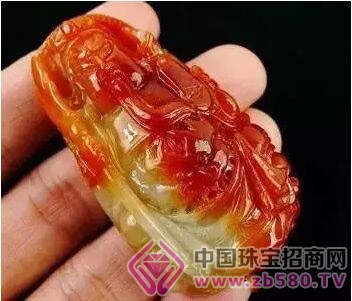The red jadeite in the jade (commonly known as "red dragonfly") is used to symbolize auspicious celebrations. It is a carrier for the use of certain carvings. The red dragonfly in the jewelry market is increasing and the price is also rising. However, the market is often used to optimize the processing of red dragonfly, such as burning red jade and dyed red jade, with these optimized treatment of red dragonfly to pretend to be a natural A cargo red dragonfly.
Natural A goods jade ice type red dragonfly faucet pendant
First, the characteristics of burning red jade
Burning red jade (also called ç¿¡è‰²ç¿¡ç¿ ) is an optimized treatment method for jade. This method usually puts the darker, lower value yellow or brownish jade into the furnace at a certain temperature. Boil it down to make it bright red.

Burning red jade
"Burn red" is a physical method of coloring, it does not change its internal structure, has not been chemically treated, so it is still a cargo jade. Burning red jade is much less natural than natural red enamel because its color is not naturally formed. So how do you judge whether the jade jewelry is "burning red" jade?
1, the degree of vividness
Natural red dragonfly is often dark and dull, brownish red, with varying colors and layering; burning red jade is often bright red, bright color, relatively single, no layering.
2, the texture is delicate
The texture of natural red jade is relatively round and delicate; the texture of “burning red†jade looks rough, dry and grainy.
3, color boundaries
The natural emerald red is related to other primary colors (white, green or purple), especially in the place where the red dragonfly is, there will be a clear boundary; the "burning red" jade color boundary is not clear, which is a gradual transition relationship.
4. Transparency
The natural emerald red part will be relatively transparent, especially the boundary part will have better transparency; the red emerald color has little change in transparency between the different colors, and the red part sometimes has poor transparency.
5, the surface is smooth
The natural ochre jade is polished and smooth, and the surface is smooth and bright; the "burning red" jade will have fine dry cracks, the smoothness is reduced, and the reflection is weak.
Second, the identification characteristics of dyed jade

Dyed red jade
Dyed jade is commonly known as C goods, which belongs to the treatment of jade. However, the dyed red jade and natural red peony are the secondary colors superimposed after the formation of jade, and the coloring agents are similar, all of which are iron oxides. Therefore, the identification of red jade is far more than dyeing green and dyeing purple jade. The identification is much more difficult. The main identification characteristics of red jade samples are:
1, color characteristics
The color of natural red dragonfly often has a certain gray tone and is not bright enough. Red and bottom sheets often exhibit a mutated relationship, and red is a deeper ribbon. The color of the red jade is brighter, without gray tone, and the color distribution is more uniform. The red and the bottom sheets are in a gradual relationship, and the more the appearance, the more the red becomes lighter.
2, structural characteristics
Natural red mites have a typical dendritic and vein-like structure due to the small number of small fissures and the secondary minerals filled in the fissures. The materials selected for dyeing red jade often have no cracks or healing cracks. The red dye of red jade is infiltrated into the jade through the capillary gap and filled in the gap of the crystal grains to form a three-dimensional grid resembling loofah, which is called a loofah structure.
3. Infrared spectral characteristics
Natural red peony has a typical absorption peak of 3695 cm-1. Dyeing red jade needs to be kept at a relatively high temperature for a period of time, which will cause some of the adsorbed water and water-containing secondary minerals in the jade to dehydrate and lack the absorption peak of 3695cm-1.
4, Raman spectral characteristics
Natural jadeite is mainly composed of pyroxene minerals, and does not contain the bond of organic matter. There is no characteristic peak in the organic bond region, and only the Raman peak unique to red peony. The dyed red enamel has many characteristic peaks of Raman in the organic bonding region of 1100 cm^(-1) to 1700 cm^(-1), and it is judged that these organic bonds are artificially added coloring agents.
Embroidery is a general term for various decorative patterns embroidered on fabrics by needle and thread. Embroidery is divided into silk embroidery and feather embroidery. It is a kind of decorative fabric that uses a needle to puncture silk thread or other fibers and yarns with certain patterns and colors on the embroidered materials, and then forms the decorative pattern with the embroidery trace. It is the art of adding human design and production to any fabric that exists with needles and threads. Embroidery is one of the traditional Chinese folk crafts, which has a history of at least two or three thousand years in China. Chinese embroidery mainly includes Suzhou embroidery, Hunan embroidery, Shu embroidery and Guangdong embroidery. Embroidery techniques include: wrong needle embroidery, random needle embroidery, net embroidery, all over embroidery, lock silk, nasi, Najin, Pingjin, Yingjin, Panjin, fluting, scraping, poking, sprinkling, cross stitch, etc. the main uses of embroidery include life and art decoration, such as clothing, bedding, tablecloth, stage, art decoration.
Accessories Embroidered Patch,Embroidery Patch Hat,Patch Embroidery Posts,Flower Embroidered Patches
Shenzhen Longxiang embroidery products Co., Ltd , https://www.lxembroidery.com